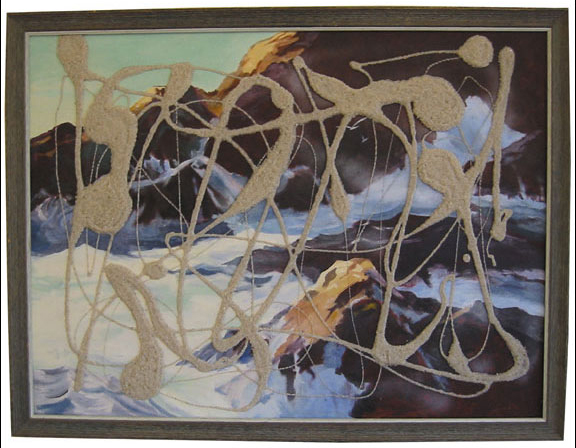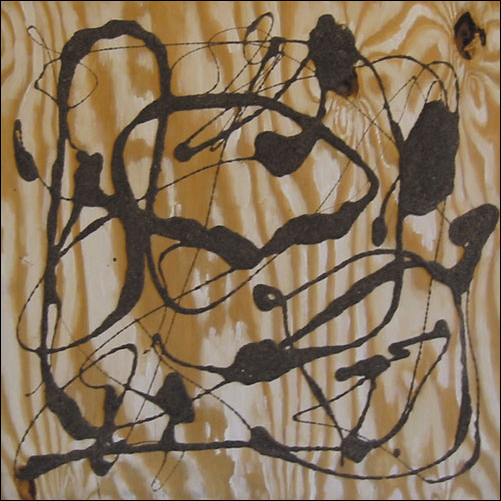John Perreault Seascapes
John Perreault seascapes capture something very essential about the sea. They are works that embody the quicksilver changes of the ocean, encompassing both its spatial and metaphorical complexity. Through calligraphic marks with sand and binder, painted on found seascapes and plywood panels, Perreault evokes natural rhythms of the tide, brine on the crest of a wave, the play of light on water and the movement of the sea as it covers and depletes the shore. By combining unlikely genres and techniques he attains a gestalt effect which is close to the spirit of the sea.
Found Seascapes
During a 2003 C-Shack residency in the Provincetown dunes, Perreault began to make paintings with with Elmer’s Glue and sand. Later that year, at a Long Island yard sale, he bought a paint-by-number seascape over which he dripped a pattern of sandy impasto with repetitive circular movements. The results were highly intriguing, and Perreault began to ply yard sales and thrift stores for seascapes. For the most part he selected banal works realized by mediocre painters to brighten up hotel rooms on Long Island Sound.
Perreault would then gather sand. Most often he uses local sands, but recent works have included sand from his travels, including an exotic black sand from Hawaii that once issued from a volcano. By way of his circular patterning, Perreault draws the viewer’s attention from illusionistic deep space of the found painting to these linear marks. But the sandy impasto is more than a line or a pattern, constituting a sculptural presence in the work with corporeal forms and shadows that emerge from the seascape of the ocean ground.

Already in late 1940s, Jackson Pollock was exploring the relationship between his dripping paintings and the sea, alluding to it in the title of his painting Full Fathom Five. But where Pollock implies depth through chromatic diversity and layering, Perreault drips monotone impasto, drawing the viewers perception to patterns, forms, and shadows. Together with the found seascape in the background he orchestrates a dialogue between rolling waves, rocks, beaches, and the sky, with rapidly executed drippings akin in their way to the spray or frothy foam of the ocean that is both wild and uncontrollable. In nature, it is the force of waves that grind stone to sand, creating Perreault’s art material. By combining these elements, Perreault establishes an interesting rapport between reality and illusion.
Plywood Seascapes
For other works Perreault selects plywood panels as grounds for his seascape paintings. The panels privilege natural growth rings in the wood. The cross-grain patterns of the plywood at times resemble the concentric circles in a pool of water and at others the complex movements of the ocean waves seen from above. In the plywood seascape series, Perreault uses dark sand from Long Island, which is discolored by past oil spills. The sand tells a story of ecological imbalance.
Plywood like the sand is both natural and artificial, corrupted with resins that bind it together. I recall a boyhood visit to the Weyerhauser lumber mill in Oregon, where I saw logs placed on oversized lathe spindles from which they were shaved into veneer. The weight and substance of the tree was quickly reduced to a flimsy membrane, waiting to be laminated to other veneers to obtain an artificial strength. So plywood, despite the beauty of its grain, represents a violate nature.
Similarly, the black sand of Long Island is intermingled with the oily by-products of consumption and waste. Its black pigment is derived from the local petroleum spills of pleasure boats which, although contained in scope, pollute the ocean, endangering marine life and birds. For Perreault, the use of tainted materials to represent nature effects a certain correction of human transgressions.

Perreault has a longstanding interest in mystical Judaism, feeling a particular affinity with the Luriac creation story of vessels in the Cabala. According to tradition, ten vessels were filled with Divine light. Certain lower vessels were overwhelmed by the luminosity of their contents and broke into pieces. As a result, Divine light was intermingled with kelippot, the potsherds of its vessels, resulting in light bound to shadow. To rectify this problem, God initiated a process of Tikkun, or “correction.” Perreault effects such a correction by restoring natural beauty and complexity to wood and sand that have been tainted by the hand of Man.
Mended Stones
Another body of work on view consists of “Mended Stones.” They are rounded stones, found by Perreault along the seashore, that are broken and glued back together again. Two early conceptual works of the early 1970’s, intended for the garden at Wave Hill, embody Perreault’s complex relationship to nature. One consisted of writing a one-line poem in the grass with lye. Lye would kill the grass in the space of the poem. Perreault also proposed to paint an entire tree, from top to bottom, which again would ultimately have the effect of killing it. Neither piece was ever realized.

The death and rebirth of nature as art in these works reflects the shadow of creativity. Perreault implies that destruction is always present in the act of creation. Indeed, Perreault’s works are much more in keeping with the at times brutal reality of nature than most of the prettified interventions realized by artists for pastoral environments. But Perreault’s transformation of nature, by depleting part of the natural environment, heightens our awareness to what remains present. As in his current seascapes, Perreault establishes a fascinating rapport between abstraction and reality (or its depiction).
Breaking stones may seem like a primal or even primitive gesture, but the tool Perreault is crafting takes hold of our consciousness like a Zen koan. Perreault’s establishment of a duality within these stones clarifies our understanding of pristine nature. Mended stones also speak to a mythic nature with its dualities of masculine or feminine and creation and destruction, which runs like a deep ocean current in the unconscious.
© Daniel Rothbart, 2004.